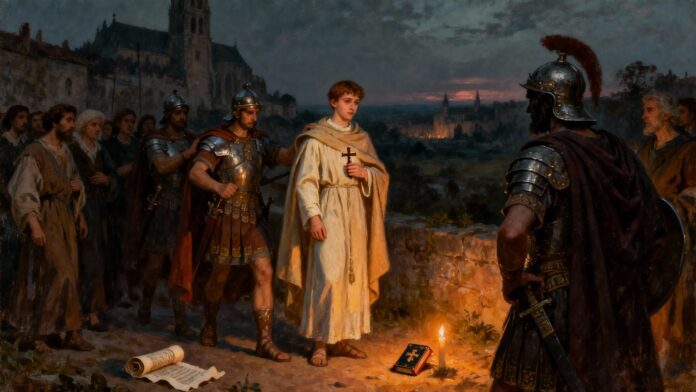Saint Quentin, a young Roman sent to Gaul in the 3rd century to spread the Gospel, died in Augusta Veromandum, present-day Saint-Quentin. His silent faithfulness became a beacon for all those who persevere despite hardship.

Proclaiming the faith in a new land. In the 3rd century, a young man left Rome for the plains of Picardy. Quentin preached, cared for the sick, and comforted them. His courage attracted conversions and the wrath of the authorities. Beheaded in Soissons, he left behind a testimony that founded a city and a living memory. Today, his name recalls the power of total self-giving and perseverance in daily mission.
An envoy from Rome to Gaul
Quentin was born in Rome around the middle of the 3rd century into a senatorial family. The fifth son, his name still bears witness to this. He received a solid education, nurtured in eloquence, philosophy, and a nascent faith.
When Saint Lucian, the future Bishop of Beauvais, recruited young Christians to evangelize Gaul, Quentin joined the mission. Their group crossed the Alps, then followed the Roman road to the northern plains. In Belgic Gaul, they found rural populations, faithful to their ancient beliefs but receptive to their message of peace.
Settled in Amiens, Quentin proclaimed the Gospel with simplicity. He cared for the sick, supported the poor, and taught brotherhood. His work attracted conversions, arousing the suspicion of Prefect Rictiovare, Rome's representative in Soissons. Arrested, Quentin refused to recant. The "Acts of his Martyrdom" recount his interrogations, torture, and then his beheading on the banks of the Somme River, at Augusta Veromandum.
According to tradition, his body was later discovered by a Christian woman, Eusebia, who gave him a proper burial. An oratory, then a basilica, were built on the site. Around this sanctuary, a town grew up: Saint-Quentin. Since the early Middle Ages, pilgrims have come here seeking strength and healing. The town still bears the imprint of the young missionary who became its patron saint.
The Water of Martyrdom
A tradition recounts that, during his captivity, Quentin prayed for his jailers. One day, his bonds were loosened, and he drew water to give them refreshment. At the spot where this water sprang forth, a spring is said to have flowed, healing the sick.
Medieval chronicles mention pilgrims drinking at “the Saint-Quentin fountain”, a symbol of charity stronger than fear.
Historians make distinctions without deciding: whether a matter of faith or a poetic memory, the legend reflects the inner power of the one who, even in chains, liberates.
Spiritual message
To live like Quentin is to keep the light alive even in the heart of the night. Faithfulness in adversity, quiet service, and humble words are seeds that never die. His example reminds us that faith cannot be imposed; it is offered, often in silence, always with perseverance.
Like a flame held against the wind, it illuminates without burning. Today, remember this gesture: continue to love when no one is watching.
Prayer
Lord Jesus, you who supported your servant Quentin in the fight of faith, grant us the same quiet strength.
May our words be clear without pride, our hearts faithful despite fear. Teach us to serve, to give without counting the cost, to remain steadfast when hope falters.
Through her intercession, make our days places of light where your love dwells.
To live
- Offering a moment of genuine listening to an isolated person.
- To take a concrete step towards reconciliation or forgiveness.
- Meditate for ten minutes on Matthew 5:16: “Let your light shine before men.”
Memory
The memory of Saint Quentin is enshrined in Vermandois, a region in northern France. The Basilica of Saint-Quentin, rebuilt in the 13th century, houses his relics in a unique Gothic setting.
Every October 31st, the town celebrates its patron saint with processions and services. Countless rural chapels still bear his name in Picardy, Belgium, and even England. Murals, stained-glass windows, and sculptures commemorate the young missionary with his broken chains, an emblem of free faith and fearless service.
Liturgy
- Readings/psalm: Philippians 2:12-18 – “Shine like torches in the world.”
- Song/hymn: You are the faithful God – theme of apostolic perseverance.



